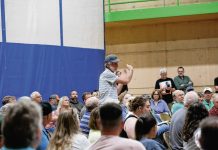Nine-year-old Dontay Lawrence crawled into a small, tent-like structure at Clifty Creek Elementary School on a recent afternoon with a simple question.
“What is this?” Lawrence asked, reaching out to touch stretchy, semi-shear, webbed walls encompassing him.
Then he saw computer video projections of fish swimming whimsically on the tent walls. When he touched them, the aquatic figures magically turned to images of expanding bubbles of water.
“Oh,” Lawrence said. “This must be technology.”
[sc:text-divider text-divider-title=”Story continues below gallery” ]
Yes — and a bit of a preview of one of the University Design Research Fellows installations for the Exhibit Columbus exhibition Aug. 24 to Dec. 1.
Michigan architect professor Sean Ahlquist brought one of his smaller playscape prototypes to Columbus last week — all to get more ideas of how it could be tweaked for autistic and other special-needs youngsters to enjoy it more when he brings a much larger model to Exhibit Columbus.
At that time, the piece will be placed in front of The Commons at 300 Washington St. in downtown Columbus. The miniature structure that Ahlquist brought to a couple local schools and to the kidscommons museum to test market cost about $2,000 to make, with help from civil and aerospace engineers and a computer software program.
“People really don’t fully understand what happens with this until they see children interacting with it,” Ahlquist said as he watched Clifty Creek students move in and out of the playscape.
Sometimes, people understand the playscape even better when they see how special-needs youngsters respond after interacting with it. For instance, one autistic student who spent a few minutes inside it at Clifty Creek was stimulated and fascinated enough that he returned to the classroom more engaged and communicative with others than ever, according to an excited teacher.
“This is partly about respecting the way children want to interact with their environment,” Ahlquist said.
As a University of Michigan assistant professor of architecture, Ahlquist studies the relationship between environment and behavior for children with autism and special needs. Part of his work involves improving tactile sensitivity in people with autism to then help encourage collaborative play.
Ahlquist also is the father of 9-year-old daughter Ara, who has autism and is non-verbal. So his work is both very emotional and personal and yet very analytical and professional.
As he videotaped youngsters playing, he greeted them in a warm, gentle voice. And, as each child finished playing, he brightly asked them, “Can I get a high-five?”
He makes his own stretchy, webbed fabric for the playscape’s walls via his own industrial knitting machines at his lab at the University of Michigan in Ann Arbor. That’s where he and others designed the playscape, engineered it, and fabricated it. He even has personally selected the Spandex-like yarn used in the creation.
“We want an environment in which the kids can really feel precisely how they are manipulating it,” Ahlquist said as he watched special-needs students push and pull on the fabric. “We want to help them find the most comfortable, engaging sensory action they might want to experience.”
Amber Wolf, one of the autism coordinators for Bartholomew Consolidated School Corp., was more than enthusiastic as she watched students play inside and around the structure.
“I think it’s fabulous,” Wolf said. “We’ve seen some pretty neat things here today.
“With something like this (structure), sometimes some students can get over-stimulated. But I think this (playscape) is amazing. I have never seen anything like it.”
She crawled around in it a bit herself.
But Clifty Creek Elementary School Principal Michael Parsons chuckled and acknowledged that his 6-foot-9-inch frame is hardly ideal for such a structure meant mainly for the pint-sized crowd.
However, Parsons loved the idea of having the playscape take over his office Thursday for the sake of some of his students.
“I think this is a great opportunity for our kids to experience something they haven’t experienced before,” Parsons said. “Life is about learning from things we haven’t experienced before now. And we hope many of the kids will get to replicate this experience with the bigger one that will be at The Commons (in August).”
[sc:pullout-title pullout-title=”About Sean Ahlquist” ][sc:pullout-text-begin]
Age: 46
Role: Assistant professor of architecture at the University of Michigan in Ann Arbor studying the relationship between environment and behavior for children with autism and special needs. Also the father of Ara, his 9-year-old non-verbal child who has been diagnosed with autism.
Columbus connection: One of the University Design Research Fellows for Exhibit Columbus slated from Aug. 24 to Dec. 1 — and the creator of a tent-like “sensory playscape,” as he calls it, for special-needs youngsters.
[sc:pullout-text-end][sc:pullout-title pullout-title=”About the playscape” ][sc:pullout-text-begin]
Architect Sean Ahlquist’s tent-like playscape prototype that he just brought to several Columbus locations, including kidscommons, to receive feedback from youngsters on how to improve it, is constructed of a filmy, webbed, stretchy fabric. It is held together to stand upright with glass fiber rods.
A computer program in the back portion of the structure projects the image of fancifully swimming fish on the playscape walls.
The four-foot-wide playscape he brought here was rugged enough to withstand children’s pushing and pulling on it. And Ahlquist can quickly replace worn or torn fabric with new sheets via his own industrial knitting machines.
The playscape he plans to bring to Exhibit Columbus will be about four times larger and will be stationed in front of The Commons at 300 Washington St.
[sc:pullout-text-end][sc:pullout-title pullout-title=”About the Exhibit Columbus exhibition” ][sc:pullout-text-begin]
The Exhibit Columbus exhibition is a once-every-two-years display of a wide variety temporary architectural installations meant to highlight or somehow connect to nearby, permanent structures and buildings in Columbus.
The exhibition is set for Aug. 24 to Dec. 1 and is an exploration of art, architecture, and design.
Exhibit Columbus seeks to celebrate Columbus’ heritage while making it relevant in new and modern ways, according to organizers. It is the signature project of Landmark Columbus, which was created in 2015 to care for the design heritage of Columbus, and is under the umbrella of The Heritage Fund — the Community Foundation of Bartholomew County.
To learn more, visit: exhibitcolumbus.org
[sc:pullout-text-end]




